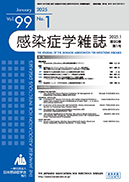
- 4 号 p. 323-
- 3 号 p. 301-
- 2 号 p. 95-
- 1 号 p. 1-
- |<
- <
- 1
- >
- >|
-
太田 玲子, 大宮 卓, 勝見 正道, 西村 秀一2025 年 99 巻 4 号 p. 323-331
発行日: 2025/07/20
公開日: 2025/07/20
[早期公開] 公開日: 2025/07/02ジャーナル フリーSARS-CoV-2の感染力はCycle Threshold(Ct)値からRNA量を推定し判定することが多い.しかし,Ct値では異なるアッセイ間での比較が困難である.また,RNAの検出が感染性ウイルスの存在を示すとは限らないことからウイルスの感染力を推測するためにはRNA量と感染性ウイルスの関連を明らかにすることも求められる.
今回我々は核酸精製を行わないreal time reverse transcription-polymerase chain reaction法と核酸精製を必要する従来法を比較するために核酸精製を行わない方法でRNA定量が可能かを検討し,RNA量を求めた.さらにそのRNA量と従来法のRNA量をウイルス分離結果とともに比較検討し,核酸精製を行わないことによる定量値への影響をRNA量とウイルス分離結果との関連に注目しながら症状別に検討した.
その結果,核酸精製を行わない定量法は再現性,希釈直線性,従来法との相関(相関係数0.79,p< 0.001)は良好であった.さらに測定範囲も従来法と同等であったことからRNA精製を行わないことによる定量値への影響は少ないと考えられた.また,両方法はウイルス分離結果との関係においても同等の結果を示した.RNA量が<104copies/mLではウイルス分離陰性,≧106copies/mLではウイルス分離陽性の可能性が高いことが示唆され,これらの値は感染力推定に有用であると考えられた.RNA量が104≦ <106copies/mLの検体では有症状では感染初期の感染性ウイルスが存在すること,無症状では感染性ウイルスが存在しない割合が高いことが推測された.
抄録全体を表示PDF形式でダウンロード (427K)
-
生成 諒, 田中 康博, 大路 剛, 薬師神 公和, 田代 敬, 常峰 紘子, 有馬 靖佳2025 年 99 巻 4 号 p. 332-338
発行日: 2025/07/20
公開日: 2025/07/20
[早期公開] 公開日: 2025/07/02ジャーナル フリー患者は70歳の女性で,Mycobacterium aviumによる非結核性抗酸菌症(nontuberculous mycobacterium,NTM)に対し治療を行っていた.白血球数の異常な増加を認め,成人T細胞白血病・リンパ腫(adult T-cell leukemia/lymphoma,ATLL)と診断し,真菌感染症予防のためにミカファンギンの投与を行い,同種造血幹細胞移植を実施した.移植後9日目から発熱が持続し,移植後14日目の血液培養からLomentospora prolificansが同定された.ボリコナゾールやテルビナフィンなどの抗真菌薬を投与したが移植後33日目に死亡し,剖検を行った.
L. prolificansは血液悪性腫瘍や造血幹細胞移植,固形臓器移植のレシピエントなど重度の免疫抑制患者において感染のリスクが高くなることが知られている.L. prolificans感染症は稀であり,ほとんどの抗真菌薬に対して耐性を示すことが多く,治療は困難を極める.
NTMを伴うL. prolificans感染症の症例は限られているが,肺の空洞性病変の存在がL. prolificans感染症のリスク因子であることが示唆されている.我々が検索する限り,ATLLに関連するL. prolificans感染症の症例はこれまで報告されていない.NTMの患者では,重度の免疫抑制状態となった場合,特に造血幹細胞移植後などではL. prolificans感染に注意を払うべきである.また,L. prolificans感染症に対する効果的な治療プロトコルの開発と標準化には今後さらなる研究が必要である.
抄録全体を表示PDF形式でダウンロード (787K) -
髙橋 晃史, 仁木 誠, 佐藤 信浩, 武呂 誠司, 黄 文禧2025 年 99 巻 4 号 p. 339-344
発行日: 2025/07/20
公開日: 2025/07/20
[早期公開] 公開日: 2025/07/02ジャーナル フリーA 35-year-old man presented to a neighborhood clinic with mild pain in the right buttock in August 20XX. The physician suspected infection and referred the patient to our hospital for further evaluation and treatment. Pelvic Computed Tomography (CT) revealed a large abscess involving the right iliopsoas muscle and periphery of the hip joint, and we performed ultrasound-guided percutaneous drainage. Gram staining of the aspirated specimen revealed gram-negative filamentous rods. We had started the patient on empiric antibiotic therapy with cefazolin; however, based on the finding of Gram staining, the antibiotic regimen was escalated to piperacillin/tazobactam.
Due to challenges in bacterial identification by standard culture techniques, we referred the isolate to the Osaka Metropolitan University Hospital's Infection Control and Prevention Department for further analysis. Matrix-Assisted Laser Desorption Ionization-Time Of Flight Mass Spectrometry (MALDI-TOF MS) and 16S rRNA sequencing at that department identified Aggregatibacter aphrophilus as the causative organism.
The patient gave a history of dental treatment, which was suspected as the potential source of bacteremia leading to the formation of a perihip abscess. Appropriate management of such infections requires timely abscess drainage, accurate identification of the causative organism using susceptibility testing, and targeted antimicrobial therapy.
抄録全体を表示PDF形式でダウンロード (487K)
- |<
- <
- 1
- >
- >|